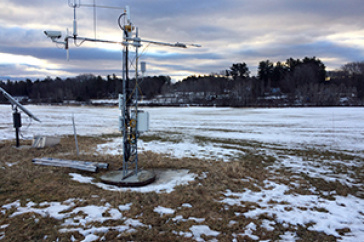The University of New Hampshire is a flagship research university that inspires innovation and transforms lives in our state, nation and world. More than 16,000 students from all 50 states and 71 countries engage with an award-winning faculty in top ranked programs in business, engineering, law, health and human services, liberal arts and the sciences across more than 200 programs of study. UNH’s research portfolio includes partnerships with NASA, NOAA, NSF and NIH, receiving more than $100 million in competitive external funding every year to further explore and define the frontiers of land, sea and space.
UNH Research Finds Warmer, Snow-Free Winters May Increase Carbon Dioxide Losses in Forests, Gains on Farms

Tower with automated sensors at Kingman Farm hayfield in winter. Credit: Elizabeth Burakowski
DURHAM, N.H. – New England’s warmer, snow-free winters may increase carbon dioxide losses in forests, where deciduous trees can’t take advantage of warm temperatures before their leaves emerge. However, farms cultivating grasses have a greater potential to start growing in the winter “dormant season,” perhaps partially offsetting the increasing winter carbon losses from forests, according to new research from the University of New Hampshire.
“New England’s winters are becoming increasingly variable, but the effects on different ecosystems, such as forests and farms, are poorly understood,” said Rebecca Sanders-DeMott, a postdoctoral research associate supported by the New Hampshire Agricultural Experiment Station. “We are trying to determine how changing winter conditions will affect how plants and soils in these ecosystems process carbon. The flow of carbon provides a unique picture of the health and function of ecosystems: uptake of carbon dioxide occurs when plants photosynthesize and grow, while carbon dioxide losses are a result of respiration by both plants and the microscopic organisms that live in soils.”
“Forests and agricultural lands provide critical services for the people of New Hampshire and New England, such as energy, food, and support for tourism and lifestyle,” said Sanders-DeMott.
To evaluate the impact of warmer, more variable winters on New England ecosystems, Sanders-DeMott and her collaborators have been using sophisticated instrumentation since 2014 at the experiment station’s Thompson Farm forest in Durham and Kingman Research Farm hayfield in Madbury to continuously monitor how much carbon dioxide is moving into and out of the ecosystem.
Automated sensors mounted on towers above the vegetation canopy measure wind speed, air temperature, and carbon dioxide concentrations 10 times every second. By examining the uptake and loss of carbon at each site across several winters with variable weather conditions, scientists are learning about how winter climate affects ecosystems that are important components of the New England landscape.
In addition, they have been making daily measurements of snow and soil frost depth at Thompson and Kingman farms. These data will help researchers understand how the effect of snow on soil temperatures and frost depth affects the patterns of carbon dioxide uptake and loss from forests and grasslands.
“We have experienced a lot of variation in winter weather in just the last few years. While winter 2014-15 was quite cold and snowy, winter 2016-17 was on the warmer side of what we consider normal, and in the winter 2015-16 we saw the warmest air temperatures ever recorded in New England,” said Sanders-DeMott. “Conditions in winter 2015-16 were so warm that the grasses began growing in February and kept growing into the summer. This early growth resulted in the grassland becoming a sink for carbon dioxide -- taking up and storing more carbon dioxide than it released -- in February to April of 2016, whereas in a typical year the grassland would be a carbon dioxide source during this period.”
In contrast to the grasses, she said the Thompson Farm forest showed a more sluggish response to the warm 2015-16 winter. Although the evergreen pine trees started to grow earlier than normal, the deciduous maples and oaks hadn’t yet produced new leaves and couldn’t capitalize on the warm weather. Instead, the warm temperatures and lack of snow caused unusually high levels of respiration in soils and a very large loss of carbon to the atmosphere. Although the forest usually loses carbon dioxide to the atmosphere during this time of year, in 2016 the amount of carbon dioxide lost was three times greater than a typical year.
This material is based upon work supported by the NH Agricultural Experiment Station, through joint funding of the National Institute of Food and Agriculture, U.S. Department of Agriculture, under award number 1006997, and the state of New Hampshire. Sanders-DeMott also is supported by an experiment station Postdoctoral Scientists Support Program Award. Additional funding for this project comes from NH EPSCoR/NSF Research Infrastructure Improvement Award EPS 1101245 and NASA Carbon Cycle Science NNX14AJ18G.
Founded in 1887, the NH Agricultural Experiment Station at the UNH College of Life Sciences and Agriculture is UNH’s original research center and an elemental component of New Hampshire's land-grant university heritage and mission.
PHOTOS AVAILABLE FOR DOWNLOAD
https://colsa.unh.edu/nhaes/sites/colsa.unh.edu.nhaes/files/media/images/photo1.jpg
Forest understory with melting snow at Thompson Farm forest. Credit: Rebecca Sanders-DeMott/UNH
https://colsa.unh.edu/nhaes/sites/colsa.unh.edu.nhaes/files/media/images/photo3.jpg
Tower with automated sensors at Kingman Farm hayfield in winter. Credit: Elizabeth Burakowski
-
Media Contact
Lori Tyler Gula, PhD | NH Agricultural Experiment Station | lori.gula@unh.edu | 603-862-1452
Latest News
-
December 12, 2024
-
December 11, 2024
-
November 22, 2024
-
November 7, 2024
-
October 30, 2024
















































